When Rickford McKenzie lost his leg in 2010 he never expected that two years later he would have completely lost his ability to walk. Though the odds are now stacked against him McKenzie, now a double amputee, has been thrown a lifeline.
The Ptolemy Reid Rehabilitation Centre has given a commitment to help McKenzie live a normal and better life by not only advising him how to eat well and take care of his body but also get prosethes.
McKenzie through monetary assistance from the National Insurance Scheme was able to get a prosthetic leg after his first amputation. He will now have to seek further assistance from NIS to get another one.
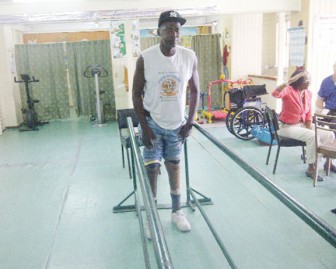
A few weeks ago this newspaper had published McKenzie’s story in which he pleaded for assistance in getting a wheelchair so that he could sometimes venture outside his modest home to get some fresh air. Since the second amputation in February of this year, he has been confined to his Grove Squatting area, East Bank Demerara home doing nothing more than sleeping or sitting around watching television.
However Administrator Cynthia Massay believes that McKenzie is too young to be confined to a wheelchair. She is of the firm belief that with good rehabilitation and commitment from McKenzie, he could be fitted with prosthetics which would strengthen his chances of getting a job and leading a normal life.
“Even if he doesn’t get a job, he needs to be as independent as he can on his own to do things, so he doesn’t put pressure on his wife… If he sits in a wheelchair, what I think will happen is that in a few years time there will be no more Mr Mckenzie,” she said during a recent interview with this newspaper. McKenzie, a former city constable, is 56 years old.
Massay who has been at the centre for over 20 years said that when she first read the article, it gave the impression that there were no services available to rehabilitate him. She added that she later read that Clive Lloyd wanted to donate a wheelchair to the double amputee.
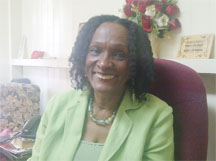
Massay explained to Stabroek News that there are many organizations in Guyana that provide wheelchairs through donations from overseas, so McKenzie would have no problem sourcing one locally free of cost.
“When these [overseas based] organizations see a story like this they get the impression that a man cannot get a wheelchair here,” she said, adding that for him to be confined to a wheelchair for the rest of his life did not sound like an ideal situation.
“I wonder why he could not be fitted with prostheses,” she said, adding that it was after she contacted him that she learnt that he was fitted with a prosthetic leg after the first amputation which was done on July 22, 2009.
McKenzie never visited the centre until January of the following year when he underwent the necessary rehabilitation in order to effectively use the prosthetic leg.
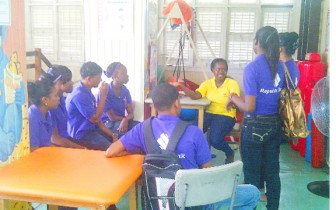
“If he had had an amputation previously every care should have been taken to ensure that his other leg did not get affected. The fact that it had been amputated means that that did not happen,” she observed.
Several days after the interview with Massay, Stabroek News spoke with McKenzie at the centre. He explained that this was his first visit back after his second amputation.
When this newspaper arrived he was doing some lower body exercises and within minutes he was tired. He admitted that he had failed to do his exercises while at home and was instead just sitting around. He told Stabroek News while gasping to catch his breath and with sweat running down his face, that given his present state he is committed more than ever to being rehabilitated, while pointing out that he has no other health complications besides type two diabetes.
Ernesto Campo, the physiotherapist who is working with McKenzie said that now that he had returned to the centre, he will have to be reassessed. He explained that he realizes that he is getting weak and tired very quickly and as such they will have to work at a slower pace.
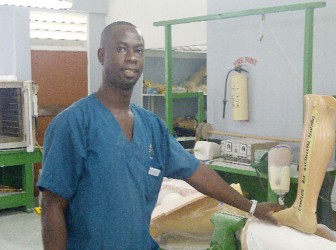
He explained that McKenzie will be doing lower body work out and exercising his arms.
Later he will be fitted with his first prosthetic leg and he will have to hop around on it until he gets accustomed to it and can balance. He will also walking on it using hand rails.
Once he can balance effectively, he will be measured and fitted with the other prosthetic leg. Thereafter he will be carefully monitored to ensure that he can effectively use the appliances.
At the moment the only problem that McKenzie faces is that the recently amputated leg does not have the right shape. It was later explained to Stabroek News that the leg has to be strapped during exercises so as to help get it into the correct shape. Massay said that McKenzie will be taught the `stump’ exercises which would help shape his recently amputated leg, while pointing out that exercising the other leg will also be very important.
Owing to the fact that he hasn’t been exercising, the knee of his first amputated leg has become very stiff and this could be a setback for him if he does not work on it now. The other leg was amputated above the knee.
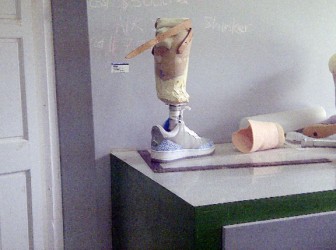
Massay said that if he is going to be able to use the prosthesis properly then he has to exercise regularly and follow his diet. “The main problem with diabetics is the diet. If you follow your diet, exercise and take your medication you will get many more years,” she told him.
McKenzie later explained that he was taking the medication he had gotten from the Grove Health Centre but one day earlier this year, he suddenly saw two small boils on his foot.
“When I do go to the clinic it was already gone already. I didn’t go right away” he said, explaining that the doctor wanted to save his foot and a decision to amputate was taken long after, and by then most of his foot had already been affected.
Stabroek News was told that for a diabetic, a foot can go bad in a matter of days if it is not cared for properly.
Massay speaking from first-hand experience, because she has to help her husband battle the disease, that a cut on a diabetic’s finger takes months to heel. She referred to the experience of a friend whose toe was bruised as a result of wearing a new pair of shoes and which took a year to heal completely.
NIS and diabetic persons

Melanie English, the NIS rehab assistant and member of the Guyana Diabetic Foot Care Project said that the scheme can do little to assist diabetic persons to purchase testing kits and strips, but in the event that they have an amputation, NIS would cover 80% of the cost of the prosthetic leg.
English, who is familiar with McKenzie, said that he has gained quite a bit of weight since she last saw him in February. Because of the nature of her work she is sometimes at the Diabetic Foot Centre at the Georgetown Hospital.
She explained that McKenzie had applied for disability benefit and whether he receives it, will depend on a doctor’s evaluation which will be conducted shortly. English explained that if he is granted that benefit it would be as though he were getting an early pension, but once he reaches 60 the money he receives will be called the old age benefit.
In other words, McKenzie will get no additional money because of his condition, as according to English the sum will be calculated on the basis of his contributions to the scheme. Even if he doesn’t get the disability benefit, the majority of the cost for his other prosthetic leg will be covered by the scheme, English explained.
She said that at the Diabetic Foot Centre the main aim is to avoid an amputation, but the patient also has to work hard. She said that in her experience while patients are given the medication, “if they don’t change their lifestyle it makes no sense.”
She like Massay said she wouldn’t like to see McKenzie confined to a wheelchair because, “he is only 56; he has a lot ahead of him.” English added that even though he has retired he can still do something to occupy his time. “It all depends on the patient’s mindset. The whole aim is to rehabilitate him,” she stressed. She later explained to this newspaper that diabetics should eat five times a day; three main meals and two inbetween snacks. “The main problem we have here is adjusting your lifestyle after finding out you have diabetes. We just have to keep encouraging them to change their lifestyle. The lifestyle change is a gradual process and we work with the patient to help them change their eating habits,” she said.
Owing to McKenzie’s financial situation, and the fact he is required to pay a $4000 return taxi fare to the city once a week for rehab at the centre, it was agreed that English would visit him at his home twice a month. McKenzie would visit the centre for a check-up every other month.
Massay agreed that it was very difficult for people in his condition who cannot afford it to come to the city. She said that if there was a rehab service on the East Bank it would help the situation.
The work of the centre
Massay told Stabroek News that the centre offers many services to children and adults with disabilities,
And that it provided the main services for children with physical and developmental disabilities. Additionally it also makes available a weekly rehabilitation service for amputees.
She explained that the centre started out as a polio centre for children, adding that prosthetics were done there because children suffering from this disease were paralysed. As a result a shop was built which provided the orthotics. But over the years it has expanded so now it is the National Orthotics and Prosthetics Appliances workshop.
According to Massay, the centre has been registered as the National Rehabilitation Complex, although the name Ptolemy Reid is used.
She said that the shop provides braces and prosthetics for the whole country, and that it is one of a kind, servicing all the regions through outreach clinics.
Asked how one becomes eligible for prosthetics, she responded that persons are usually referred from the hospital while a few come in on their own.
She explained that a person needs prosthetics after being in an accident, experiencing some sort of trauma or as a result of diabetes. The bulk of the amputations, she added are done at Georgetown Hospital.
Massay added that although they people should be referred to the centre, this was not always done:
Also, she noted, the centre has an audiology programme where persons are fitted with hearing aids. The diagnostic part is done at the Georgetown Hospital through their rehab services, and thereafter the persons are referred to the centre for their ear moulds and the actual fitting of the hearing aid. Servicing and maintenance are also done at the centre, she informed this newspaper.
Later she said that in 1992, the centre was allowed to delink from the Health Ministry and although the organization is a non-governmental organization (NGO), the ministry is its biggest donor. Massay said that the centre receives a subvention every year and the ministry pays the bulk of the staff. Teachers who teach the children are paid by the Ministry of Education. The management committee donor programme, provides all the funding for the other expenses, she said, and additional income comes through project funds.
At the moment the centre caters for 50 school-age children and another 25 in the daycare dormitory area, Massay said, adding that there are five residents. The outpatient clinic sees over 100 children per year.
The amputee clinic seea up to twenty persons on a really busy day.
She went on to say that the centre provides speech, occupational therapy and physiotherapy, as well as special education inclusive of a vocational unit for the teenagers to learn a skill. Commenting on the difficulties the centre faces, Massay said that there is inadequate staffing: “One of our main issues here is professionally trained staff in all the sections,” although the centre is collaborating with the Education Ministry to get trained teachers. “We are a special school and we should have specially trained teachers and that is the problem. We are working with a consultant from NCERD who is working with our teachers,” she said. However, the therapy department and the workshop are still severely affected by a staff shortage, and where there should be six technicians in the latter there are only two.
Amputees
Massay told Stabroek News that the centre is the only organization in the country providing prosthetics and that the main reason for amputation is uncontrolled diabetes. The amputees at the centre range from the mid-40s and up.
She said that there is a session for amputees every Thursday and on that day the centre is usually packed. The Diabetic Foot Clinic, she said, has made a tremendous difference in the number of persons having amputations.
Massay told this newspaper that most times it cost over $300,000 for an above knee prosthetic leg, which is still cheap when converted to $US. “We provide the very basic functionary appliances. People cannot afford the technologically advanced appliances,” she added.
She said that the staff and specialist personnel during sessions with patients address the issue of proper diet and how to care for themselves.
Massay said that the centre also does prostheses for the upper limbs, but those are very few because of the cost, and the machinery to do it is not even in Guyana. “If a person wants it, they can get a cosmetic arm,” she said, explaining that once the funding is sourced the necessary components will be ordered and the appliance made.
Stabroek News was also told that if someone loses a toe, they can get a toe block at Ptolemy Reid. It is pasted onto the sole of the shoe filling the space so that there will be no rubbing or lacerations.
Massay advised all to have at least a yearly check-up once they have attained a certain age, and once they are diagnosed then they should comply with the advice given by professionals. If the disease runs in the family, she emphasized, “then you should take even more precautions.”





